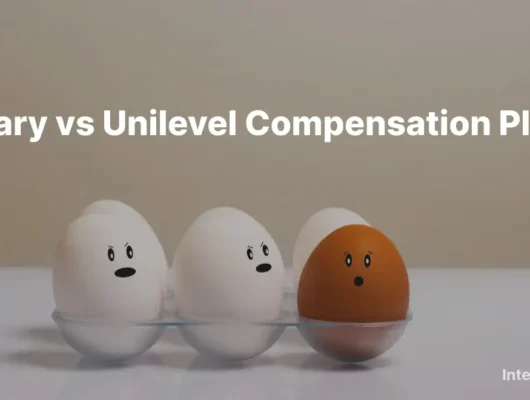Unilevel MLM Plan with its straightforward organizational structure and Matrix MLM Plan with its organized and predictable approach, have been two of the most popular compensation plans in the MLM industry. They are utilized to reward and motivate the participants. Each of these offer unique benefits catering to various business strategies and distributor preferences.
The simplicity, structure and earning potential offered by these two compensation plans vary in different proportions to suit the requirements of different organizational structures. If you are finding it difficult to draw down on which network marketing venture, let us guide you through everything you need to know about them!
Table of Contents
Understanding Unilevel MLM Compensation Plan
The Unilevel Compensation Plan is a favourite due to its simplicity, extensive client base and unlimited earning potential. It has been successfully adopted by industry giants like Amway and Avon.
Structure:
Its straightforward organizational structure is primarily characterized by unlimited width, multiple levels and equal opportunity. The unlimited width of the Unilevel compensation plan means that the distributor can recruit an unlimited number of members in the direct downline creating a very wide network.

The number of levels beneath the initial recruits typically ranges between 5 and 10. The distributors earn commissions not only from their direct recruits, but from the levels further beneath them as well. Each distributor has equal potential of earning directly from their recruits, promoting an environment of equality and trust.
Understanding Matrix MLM Compensation Plan
When a defined number of distributors are allocated at each level, it can be called a Matrix MLM plan. The limited width and depth of a matrix structure enables the distributor to manage the size of the downline and the income potential according to the immediate needs. Herbalife and Mary Kay have successfully demonstrated the best use of the Matrix MLM Plan.
Structure:
The distributors are allowed to sponsor only a limited number of direct recruits in the downline. For example, a 3×3 configuration allows three recruits by three levels deep. Once this limited number of positions are filled in a matrix, the additional recruits spill over into the next available spot in the downline.

The depth of the downline determines the number of levels from which the distributor can earn commissions. For example, in a 3 x 3 matrix, a distributor earns from three levels of immediate downline. Hence, not only the Matrix compensation plan makes the team manageable but also offers a stable framework for earning income.
Comparing Unilevel vs Matrix MLM Compensation Plans
The key differences between a unilevel and Matrix MLM plan lies in their recruitment and earnings, structure and management, and degree of flexibility and predictability between them.
Recruitment and Earnings
- The unilevel MLM plan allows unlimited number of direct recruitments, which leads to higher direct earnings and overall higher income for the distributor. Whereas the Matrix MLM plan limits the number of direct recruits and increases the opportunity for spillover. Hence, the high direct earning potential of the distributor is being limited at the cost of team performance.
Structure and Management
- The unilevel MLM plan makes the organizational structure wide and complex which can in turn make the management of the team challenging. The Matrix MLM plan allows a controllable and manageable structure with an emphasis on teamwork and structured growth.
Flexibility vs. Predictability
- The MLM unilevel plan offers more flexibility as there is no restriction on the number of recruitments and leaves it to the best ability of the distributor to strategize. The matrix MLM plan offers a structured approach with more predictability in income and growth, but less flexibility in the earning potential.
Pros and Cons of Unilevel and Matrix Plans
Unilevel MLM Plan
Benefits :
- Simplicity:
- The straightforward and simple structure of the unilevel compensation plan makes it easy for the distributors to understand, and also to explain to and train the new recruits in. The absence of complex rules or restrictions helps the network to grow smoothly and seamlessly.
- Unlimited Earning Potential:
- Since there is no limit on the number of direct recruits, the distributors can earn a great amount in commissions from their recruitment efforts. The earning potential increases with the growth of the network.
- Fairness and Transparency:
- The success in a Unilevel compensation plan is directly dependent on the individual effort and performance. Hence it promotes a fair and merit-based environment with equal opportunity for all distributors.
- Flexibility
- The unilevel MLM compensation plan is a versatile one which is able to accommodate different types of products and business models. Along with its versatility, the unilevel structure is of a flexible nature, helping the members to build their network strategically.
Challenges :
- Management:
- The ability to recruit an unlimited number of members in the direct downline can sometimes make the downline too wide. Managing a wide downline can be challenging when it comes to supporting and training all the recruits to the desired level.
- Saturation:
- As the MLM venture grows and the market matures, the ability to find new distributors gets exceedingly difficult. Without attracting new recruits, expanding their network and exploring new market bases, it can be difficult for the members to keep up their earning potential.
- Stability:
- The unpredictability in earnings at the earlier stages of the network can demotivate the members. The fluctuations based on sales income and recruitment success rate can be drastic at first. Strong support and guidance from the upline members is inevitable for the sustainable growth of the company at this stage.
- Churning Rate:
- In the absence of immediate results, it can be very difficult to keep the recruits engaged, motivated and committed to the company. The high turnover rate that the company might experience in the beginning can have an overarching impact on the overall growth and stability of the venture.
Matrix MLM Plan
Benefits :
- Controlled Growth:
- The fixed dimensions of an MLM matrix plan prevents haphazard growth of the network. For MLM ventures in their early days, a matrix structure makes it easy to train, motivate, direct and guide a small well-structured team.
- Team Cohesion:
- The spillover of surplus recruits fosters an environment of teamwork as the distributors can help the downline by placing the additional recruits into their teams and boosting their earning potential.
- Stability:
- The defined structure of the plan allows stable and predictable income. Hence distributors can strategize and calculate their potential earnings based on the number of recruits and the levels in each matrix.
- Balance:
- The fixed structure ensures that all the distributors have equal earning potential. On top of that, even the downline members who are not yet as efficient as their peers can benefit from the spillover recruitment offered by their upline members.
Challenges :
- Spillover Limitations:
- Distributors who are innately strong recruiters might find it difficult to achieve their full potential as the new recruitments are to be distributed among their downline. This limits their direct earning potential.
- Complexity:
- A Unilevel or binary compensation plan can be pretty easy to understand and explain. However, a matrix MLM plan is complex in its structure. This makes it difficult to train the new members and help them understand the functioning of the organisation. This complexity can initially perplex and intimidate the new members.
- Limited Earning Potential:
- The defined structure of the plan allows stable and predictable income. Hence distributors can strategize and calculate their potential earnings based on the number of recruits and the levels in each matrix.
- Dependence on Team Performance:
- The limited the number of direct recruits and levels limit the potential of the members. In order to manage a decent amount of stable income, the entire team must perform optimally.
Choosing Between Unilevel and Matrix Plans
The simple structure and unlimited earning potential of the Unilevel Compensation Plan is best fit for experienced network marketers. With their experience in the industry, they can easily manage complex organisational structures and take calculated risks to achieve higher income.
For newer network marketing ventures looking forward to a less risky platform which can provide them a stable source of income along with an environment of cooperation and collaboration within the team, can go for a Matrix structure.
Conclusion
To conclude, both the unilevel and matrix MLM compensation plans have their own unique advantages that can cater to different types of network marketing ventures.
The unilevel MLM plan with its straightforward organisational structure offers unlimited learning, potential, complex organisational structure and a potential for high commissions, thrive on simplicity, fairness, and merit-based environment. Here, success is directly linked to individual performance.
The Matrix MLM plan on the other hand offers a well-defined structure and predictability by emphasising on teamwork, stability, balance in the opportunities for all the distributors with an added benefit of spillover fostering collaboration and strong team work.
The Integrated MLM software is designed to get the best out of both Unilevel and Matrix MLM plans. Depending upon your unique business requirements, the Integrated team customizes the MLM software to integrate your selected compensation plan and your organizational structure. Book your free demo today to experience the ease of doing business with Integrated MLM software.
Frequently Asked Questions
What is the main difference between Unilevel and Matrix MLM Compensation Plans?
The primary difference lies in their structure and recruitment limits. The unilevel plan allows for an unlimited number of direct recruits and has no fixed width or depth. This offer is flexible and potential for a significantly high amount of earnings.
The Matrix MLM plan offers fixed width and depth such as 3×3 or 5×5 configurations, limiting the number of recruits and levels, and thereby limiting the earning potential for a stable and predictable growth pattern.
Which compensation plan is better for new MLM businesses: Unilevel or Matrix?
For new network marketing ventures, the matrix MLM compensation plan would be more suitable because its fixed structure offers stable growth, predictable organisational structure and an easy to manage, well-supported team. The spillover effect fosters higher team cohesion boosting motivation and engagement within the team.
Can experienced network marketers benefit from the Matrix MLM Compensation Plan?
Yes, experienced network marketers can definitely benefit from the matrix MLM compensation plan, especially if they prefer stable income. However, if they are ready to make best use of their seasoned industry experience, then taking the risk that comes with the unilevel MLM compensation plan can be leveraged strategically to obtain significant earnings.
How does the spillover effect work in a Matrix MLM Compensation Plan?
The spillover effect occurs when the distributor’s frontline spots are already occupied, and there are more new recruits available with the distributor. These surplus recruits are now allocated to the next available spot in the immediate downline. This indirectly boosts the earning potential of the downline member without their apparent effort.
Is Unilevel MLM Plan more profitable than Matrix MLM Plan?
The profitability of a business model depends on various factors such as the sales strategies, team performance, product quality and unique miscellaneous factors according to each venture. With the right approach, both Unilevel and Matrix MLM plans can foster a sustainable and highly profitable growth.





